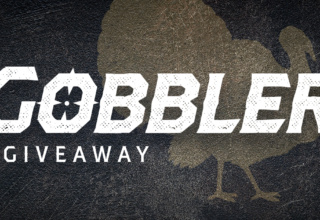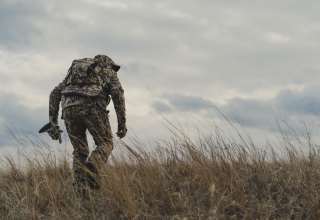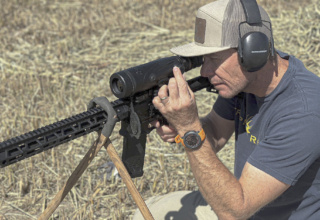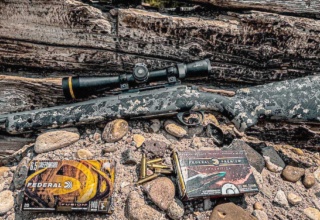Spring means different things to different people. For me, and for thousands of hunting addicts like me, spring might as well be spelled TURKEY! This spring will mark my 21st in the turkey woods. I can’t wait. My first hunt will be in Georgia. I’ve never hunted the Peach State, and matching wits with its crafty Eastern birds is a challenge I look forward to.
In preparation for this hunt, I spent some time sifting through all of my turkey calls. What a chore. Over the years I’ve amassed quite a collection of box, pot-and-peg and diaphragm calls. As I fiddled with old favorites and tuned up some new ones, my mind began to wander. I quickly realized how terrifying the process of choosing a call could be to a new turkey hunter. As the hamster wheel turned, more questions popped into my mind that many turkey hunters likely have: How do you learn to sound like a turkey? How do you know when to call and when not to call? How do you know what call to use?
My goal with outdoor writing has always been simple and pure: Write to help others. Let’s talk turkey.
Your Calling Arsenal
If you’re new to the turkey game or have a few seasons under your belt and are still unsure about the calls your vest or pack needs to harbor, let me simplify it for you. You need a trusty box call, a pot-and-peg call and a handful of diaphragms. Here’s the 411 on each. Watch the video at the bottom for a more visual reference.
Box Call

This call is used by both newbie and veteran turkey hunters across the country because it’s easy to operate and produces crisp, clear turkey tones. Box calls get their name from the hollow box-like design of the call. Attached to the box is a paddle. When you scrape the paddle against the lip of the box, you create noise. The key is making the right noise.
Keep it simple. Start with learning a single yelp. It’s common for new callers to pull the call from its packaging, line the edges of the box and the paddle with an oil-free chalk, and try to hit a long run of yelps and cutts. You gotta crawl before you can walk. Grip the box in your non-dominant hand, but don’t squeeze the life out of it. Relax your grip. Now grab the handle of the paddle. Several grips will work, but most experts prefer to grip the call with the index finger and thumb or to place the paddle between the index and middle finger. Regardless of which paddle grip you choose, keep it loose. Hold the call out in front of you and imagine a clock. The paddle is pointing back toward you at 6 o’ clock. I prefer to tilt the box downward at a slight angle, lift the paddle to about 4 o’ clock, slightly lean the paddle into the edge of the box and pull the paddle back across the edge. It may not be a perfect yelp the first time you do it, but it will come. In minutes, you’ll become comfortable with your grip and you’ll learn how to use the paddle to produce the high and low end of a yelp.
As you become more confident, you can experiment with more sounds. To cutt, tilt the right side of the box at a 45-degree angle, open the lid to 4 o’ clock and pop the lid up. Again, it takes time, but with a little practice, you’ll be yelping and cutting in no time. With a box call, you can get really excited and sound like multiple live hens.
Box calls are good regardless of the type of terrain you’re hunting. They give you the ability to get very loud, and I favor them on windy days in open terrain. Box calls also work great as locator calls. You can get a high-pitched front end that will really carry. The only time I shy from the box is on public land late in the season. Most public-land birds have been squawked at by every make and model of box call on the planet.
My go-to box calls are the new-for-2019 Clear Cutter from Primos, the Curved Lid Boat Paddle from Quaker Boy and the Smokin’ Gun from Hunters Specialties.
NOTE: In the video I used the box angled upward. Over the years I’ve learned to use a box call from virtually any angle or position.
Pot-and-Peg Calls

If I had one call to take into the turkey woods, this would be it. It’s fairly simple to use and can make all the sounds of a wild turkey. Pots come lined with different surfaces: slate, glass and aluminum, to name some of my favorites. You can easily alter tone and pitch by switching pegs. Pegs come in a number of different wood types: hickory, purple heart, rosewood, osage — the list goes on. Carbon strikers are also available.
When starting out with a pot-and-peg call, I recommend the slate surface. It’s easy to condition (more on this later) and produces a true tone. Match that slate with a purple heart striker and start playing.
Use a low-grit sandpaper to rough up the calling surface. Do the same to the tip of the peg. As with the box, grip the call with a loose grip, and be sure your palm doesn’t smother the bottom of the call. This will close the ports on the bottom of the call from which sound needs to escape. I like to tilt the pot slightly downward toward the ground, grip my peg like a pencil, tilt it slightly and draw small circles on the surface. Don’t apply too much pressure. It doesn’t take much. Drawing these circles will produce a yelp. Drawing a fishhook also works well. As with the box, start by making a single yelp. You can then experiment with different sounds.
Purring and clucking will often seal the deal on a wary tom, and a pot-and-peg call will produce true purrs and clucks. To purr, put increased pressure on the peg and let it bounce across the slate’s surface while making a half-moon motion. To cluck, place the peg on the surface, tilt it slightly, apply some downward pressure and pull the call toward you slightly until it pops.
As you master the slate surface, I recommend playing with different peg types and investing in glass and aluminum surfaces. I like a slate when calling close birds in the timber, but when I need an ear-ringer, I turn to my glass and aluminum calls.
Most of my go-to pot-and-peg calls are custom builds. I’ve been fortunate to meet a lot of call makers over the years and prefer the sound of a custom-made pot-and-peg call. A great starter call, though, is the Zink Thunder Ridge Series Pot. It’s affordable and I still use it to this day.
Diaphragm Calls

Being able to use a diaphragm effectively is a must for the serious turkey fanatic. Diaphragms produce true, custom tones and can be used hands-free. When you need to pick up your shotgun or bow, you have to put other types of calls down, which means you won’t be able to keep calling.
My diaphragm advice is simple. Spend some money and buy a few. Get some with cuts in the reed and some without. My favorite no-cut is a standard Double Reed. When it comes to calls that feature cut-outs in in the reeds, the Batwing, Shipwreck and Standard V are some of my go-tos. Experimenting with different calls will help you decide which style is right for you, especially when you’re just starting out. You’ll also want to experiment with different tape styles. There are soft tapes and firmer tapes. Try both to see if one feels better in your mouth than another.
Seat the call to the roof of your mouth. Don’t get it too far back. Doing so can engage your gag reflex. If the call feels too wide, use a pair of scissors and trim the tape. Less is more. Take your time and shave a little off at a time until you achieve a custom fit.
Push air up from you diaphragm and use your tongue to control the pressure on the reeds. As the air comes out, open your mouth. This will let the sound out. Live hens open and close their mouth to produce each note. You should follow suit.
To start, say “yelp” into the call. I know it sounds stupid and a bit elementary, but it works. Learning how to make other turkey sounds with your diaphragm is a matter of practice. Also, some calls aren’t great for certain sounds. I love to yelp and cutt on my Shipwreck but prefer to cluck and purr on my Double Reed.
NWTF Grand National Champion Billy Yargus taught me a lot about diaphragm calling, and I highly recommend watching a video (https://youtu.be/GrDwVhhOmH4) Flambeau Outdoors did with Billy and fellow NWTF Grand National Champion Matt Van Cise. You will learn a lot about how to produce exact sounds.
My favorite mouth calls are those inspired by Billy Yargus. Billy recently teamed up with Woodhaven Custom Calls, and you can find his calls, along with throngs of other Woodhaven designs, on their site or here. I’m also a big fan of the new Black Max and Sharp Tooth Jack from Rocky Mountain Game Calls.
Listen to Live Birds!
The best way to become a proficient turkey caller is to listen to live birds and try to replicate the sounds they make. Hens are very vocal in the fall when they flock together. Set your trail cameras to video mode and capture some live, in-the-woods hen sounds. YouTube is another great resource.
Get in a quiet place and record yourself on your phone using your calls. Then play those sounds against live bird sounds. I also like to practice around others. It will annoy them, but you want to learn to be fluid with your calls and be able to toss out a note at a moment’s notice.
When to Call
Listen more than you call. Calls are fun to run, but if the birds are quiet, keep your calling sparse and soft. When a hen calls, she also listens. Try to mimic her sounds and create a conversation with her. I only get aggressive with my calling when the birds I’m hunting are aggressive.
About The Author
Jace Bauserman has traveled the country chasing the wild turkey. He has harvested tons of birds both with a shotgun and archery tackle. His true joy is helping others, which he does through written word and by putting on various seminars each year. Bauserman also recently put out a new book: Turkey Hunting Tips, Tales and Tactics: Your Guide To Spring Success. It’s available HERE on Amazon.


















